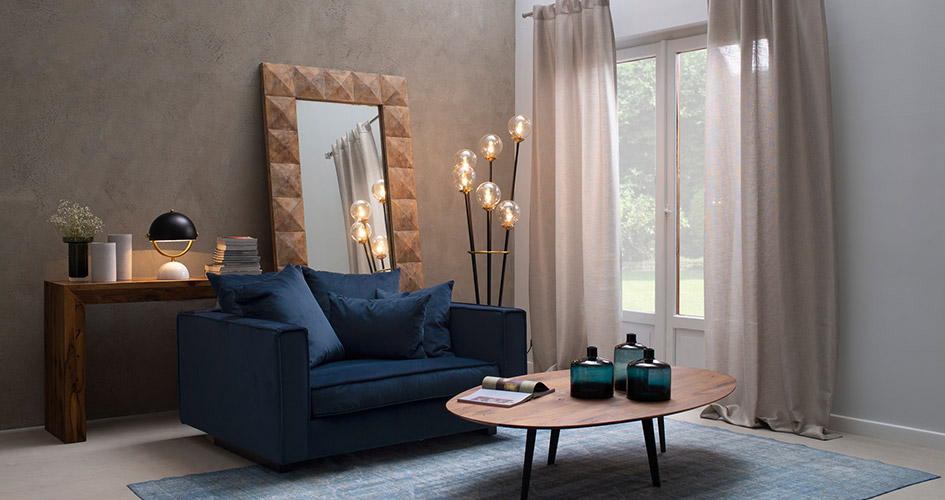
Lighting in the home - how to design it well
Designing lighting in a home is a very important moment. The right choice of lamps and their arrangement in specific rooms will affect their functionality, atmosphere, and also our well-being.
When planning lighting in your home, you always need to take into account the size, height and shape of the rooms, the arrangement of windows and the amount of natural light coming in, as well as what functions the interior and its individual zones will fulfill.

There are three main types of lighting in the home - general, local and decorative. General lighting (i.e. hanging lamps , chandeliers and ceiling lamps ) is designed to replace daylight and evenly illuminate the entire room. Local lighting, also known as directional or spot lighting, is a complement to this general lighting. It is to illuminate and highlight specific zones and places in a given interior. Decorative lighting is to expose and accentuate selected elements and details, e.g. niches, paintings , photos, trinkets or an interesting wall structure. Together with subdued local lighting, it will create the right mood and atmosphere. How to use these types of lighting in individual rooms in the house?

Light in the living room
Lighting in the living room should separate its zones and create atmosphere. It is this room, regardless of size, that requires the most diverse light and the most light points. That is why we combine both top and side lighting, which will provide light in its individual parts.

When planning the arrangement of lamps in the living room, think about where we will spend the most time and what activities we will perform there, e.g. by the sofa or armchair it is worth placing a floor lamp that will provide us with adequate light for reading books or newspapers.

If our living room is spacious and tall, we can use large, decorative chandeliers. In smaller and lower rooms, flat ceiling lamps will work better. If the interior is rectangular or square, a good solution is to hang a lamp in the middle of the ceiling to evenly illuminate it. In the case of a more complicated layout, it is better to hang several ceiling lamps in different places in the living room.
Floor lamps are most often placed next to sofas and armchairs. Their advantage is mobility - we can move them anywhere, depending on our needs. If they have adjustable arms or lampshades, we can precisely direct the light beam to illuminate a small area.
In the living room, there must also be table lamps on chests of drawers, shelves, windowsills or tables. Thanks to them, we will create a mood and emphasize specific design elements. Such lamps usually also have a decorative function. On the other hand, wall lamps will create a delicate glow on the wall and expose a decorative mirror, paintings or an interesting wall texture.
Bedroom lighting
Light in this interior should primarily create a cozy atmosphere conducive to relaxation. Therefore, spot lighting in the form of wall lamps, table lamps and floor lamps will work great here.

For those who like original solutions, we suggest hanging a decorative chandelier (this option will only work in large and high interiors) or giving up table and floor lamps in favor of hanging ones, placed on both sides of the bed. If we direct the light stream upwards, the bedroom will seem higher. If the light is directed downwards, it will create a more intimate and romantic atmosphere.
Kitchen lighting
In the kitchen, it is necessary to use several light sources. Ceiling lamps should illuminate the entire room. And spot lighting evenly distributed above the counter will make it easier to perform everyday kitchen activities. In the dining area, lamps hanging directly above the table will work perfectly. If the table is small, one light point will be enough, for a larger one it is better to use several lamps.

Light in the hallway
Lighting in the hallway is just as important as in other rooms. In the case of a small and cramped interior, we can reach for wall lighting, which will optically enlarge it. When deciding on hanging lamps, let's check their length - too short will poorly illuminate the hallway, and too long will be in the way. It is also worth remembering that a long hallway requires planning at least two or even three ceiling lamps.
The most fashionable lamp models
This season, both lamps with a subtle form and large, richly decorated chandeliers are fashionable. In the latest collections, lamps in shades of matt brass, gold or chrome dominate, as well as those with several or a dozen glass lampshades.
Among this year's trends, it is also worth paying attention to geometric lamps with open structures, light, openwork forms or expressive shapes, spider lamps with several movable arms that can be adjusted according to our needs, and lighting with raw, simple, factory-like forms.
Lighting tricks
With the help of well-chosen lighting, you can optically change the proportions of the interior. If you want to make it bigger, choose lamps in which you can direct the light upwards. In such a case, in addition to ceiling lamps, it is worth using side lighting. Wall lamps or table lamps illuminating the walls will make the room seem more spacious.

In a small room, it is worth installing lamps with adjustable arms, thanks to which we can change the direction of light and illuminate its individual zones. Let's also install overhead lighting in the form of ceiling lamps, which will brighten the ceiling and optically raise the interior. Let's also illuminate alcoves, corners and shelves. If our interior is high and we want it to be more cosy, let's use pendant lamps and chandeliers on longer cables. When planning lighting in the house, let's also pay attention to the colour of the light. Warm colour promotes relaxation and rest, and also builds mood. Cold colour helps with concentration, which is why it works well in rooms where we work. It also changes the colour scheme of the interior the least.






